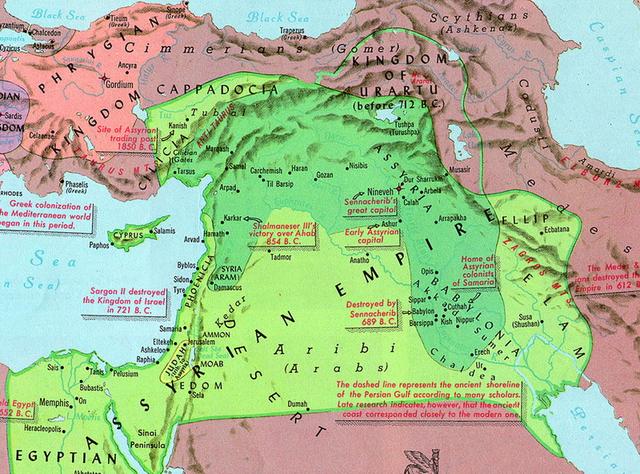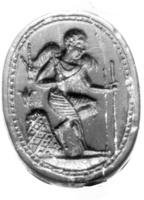Afram Barryakoub
Inscription From 800 BC Shows the Origin of the Name 'Syria'
A stone with a 2800 year old inscription sheds new light on today's Assyrian identity and the relation between the terms Suroyo, Suryoyo and Asuroyo. According to Prof. Robert Rollinger the question is solved. "Suroye or Suryoye means nothing else than Assyrians", he says to hujada.com. But Dr. Assad Sauma Assad has objections.
The stone with the important inscription was recently found in today's southeastern Turkey, more precisely in Cineköy in the vicinity of the city Adana. The archaeologists say the inscription dates from circa 800 BC, making it astonishingly 2800 years old. The striking feature of this particular inscription is its bilingual form, as it is written both in Phoenician and Luwian. Phoenician is not spoken anymore but back then it was the language of the Phoenicians who were traders along the eastern shores of the Mediterranean. Luwian is another dead language that was spoken by people in Anatolia but which later was replaced by the Aramaic language around 500 BC.
In the inscription, successfully translated by archaeologists, a local king named Urriki from the area of Cineköy tells of his relationship with the Assyrian empire. In the Phoenician version of the inscription the word Assyria is written "Assur" but in the Luwian version the same word is written "Sur". These two ways to write "Assyria" have caught the eye of the researchers as it might settle the much debated question about the names Assyria and Syria.
In the fourth issue of the highly acclaimed "Journal of Near Eastern Studies" from October 2006, Professor Robert Rollinger from the Leopold-Franzens-Universität in Innsbruck, Austria, argues that the Cineköy inscription delivers a definite answer to the question debated since the Middle Ages. Prof. Rollinger argues that the bilingual inscription proves beyond all reasonable doubt that the name Syria is only a shorter version of Assyria. Prof. Rollinger, who is considered an authority on the history, languages and cultures of the Orient, has only received positive feedback from other researchers regarding his conclusions. Positive feedback has also reached him from the Assyrian community who also has debated the question for a long-time now. The Professor has himself now put all questions aside.
"In my opinion this will put an end to all discussions, I am one hundred percent sure of it because it is written clearly in the inscription. We have the luck of finding the same text in two different languages, Phoenician on one side and Luwian on the other side, it is clearly a bilingual inscription. In the Phoenician version we have the word Assyria written in its original form with an 'A' in the beginning making it "Assur". In the Luwian version we have the same word but without the initial A making it "Sur". So the name Assyria had lost the initial 'A' in the Luwian version. Of course both "Assur" and "Sur" mean Assyria; the only difference is the usage of the shorter form of the word Assyria in the Luwian text, he told hujada.com
Prof. Rollinger states that the Greeks, who came into contact with the different cultures of the Middle East around 800 BC, must have adopted the word "Sur" and given it a Greek ending making it "Suria", a word which has lived on until this day as "Syria". The consequences of this discovery can turn out to be far reaching both for the researchers and for Assyrians, but Prof. Rollinger is reluctant to speculate on its influence for today's situation.
"Let's say it is a contribution clarifying where the name came from and finalizing the long discussion about the connection between the terms Assyria and Syria. What the Assyrian community is doing with this information, with this new result, I don't know, we have to wait and see," he commented.
What are then the consequences of Prof. Rollingers conclusions regarding today's Assyrians?
For as long as we remember we have called ourselves in our western dialect Suroye or the version with the extra "y" spelled Suryoye. And in the eastern dialect we have called ourselves Suraye or Suryaye. Both versions of the name sound very similar with the name "Sur" found in the Cineköy inscription which itself means Assyria. Could it be that Suroye, Suryoye and Suraye, Suryaye all mean Assyrians?
Did the Assyrian movement draw the right conclusions when it pointed out this connection from the beginning?
Prof. Rollinger himself has no doubt about the connection.
"I totally agree that these names mean Assyrians. From an etymological point of view, that is where the name came from, I think it is totally clear. It is an abbreviation of the name Assyria, he says and adds:
"And of course, in this area of Cilicia and northern Syria, exactly in this time we are talking about (800 BC), there were other than Assyrians; many Arameans, Luwians and Greeks. And of course the Arameans also used this expression for designating Assyria", says Rollinger and elaborates further:
"Generally speaking you have to distinguish between two aspects, one is the linguistic level, where the name comes from, and the other is the identity concerning culture, race, blood and things like that which are much more difficult and much more complicated to investigate."
"But concerning the name, it is now totally clear", says the eminent researcher.
But Dr. Assad Sauma Assad from the field of Syriology in the University of Stockholm is not as certain. Syriology is the common name for the study of the Syriac churches, the language and culture. Dr. Assad has been for a long time a strong advocate for a Syriac-Aramaic identity for our people, claiming we don't have any Assyrian identity.
But at the same time Dr. Assad is today ready to accept the connection between the terms Suroye, Suryoye and Asuroye after reading the text of Prof. Rollinger.
"It might be one hundred percent true that Suroyo and Suryoyo come from the word Asuroyo (Assyrian), but there might also surface other evidence in the future", he says and continuous by explaining that the theory long propagated by different persons on the origin of the word Suroye or Suryoye lacks historic evidence:
"All Syriac writers have throughout times unanimously explained that the word Suroye comes from a person that was called Sures or Syrus. But we haven't found this Sures/Syrus in history, so it is nothing scientific, one can call it a legend or a myth. There are many such legends people have made up in order to explain things", Dr. Assad reasons.
Dr. Assad points out at the same time that one has to differentiate between the name of a people and the ethnic identity of the people. According to Dr. Assad all Syriac Church fathers beginning from the third century AD. have associated themselves with the Arameans in their writings. One such example is the famous Saint Afram from the Third century who described the thinker Bardaysan as "Failasofo d'Oromoye" (The philosopher of the Arameans).
Dr. Assad emphasizes the fact that this was not only an occurrence in the Syriac Orthodox Church, but also in the Chaldean and Nestorian churches. This phenomenon has been explained by the Assyrian writer Johanon Qashisho who wrote that the deeply religious church fathers were greatly influenced by the negative description of the Assyrians in the Bible. The Old Testament was written by Jews who apprehended the Assyrians as enemies and therefore described the Assyrians in a biased and adversed way. That is the reason why many of our church fathers, strongly affected by the Bible, chose to deny their Assyrian origins by making excuses for their Assyrian name and associate themselves instead with the Arameans who are described in a significantly more positive way in the Bible. But Dr. Assad, who acknowledges that the word Suroye means Assyrians, maintains that we have to look beyond the linguistic aspect and understand that names can bear different meanings during different times in history.
"It is incorrect to translate the word Suroye or Suryoye to Assyrians today because it was such a long time ago that Suroyo evolved from Asuroyo. We must look at what the words mean during different periods. We cannot today use a word in the same way it was used 2600 years ago", he maintains. But further questioning shows that Dr. Assad himself does believe that we have Assyrian blood, although he his keen on maintaining that it is only to a small extent.
"The Assyrians-Chaldeans-Syriacs in Iraq, especially in the north of Iraq have some Assyrian roots. The old Assyrians no longer exist, they were killed and those of them who survived were assimilated among the Arameans. There are no Assyrian people today, nor linguistically, culturally or ethnically. They started to call themselves Oromoye (Arameans) and with time forgot that they had Assyrian roots", says Dr. Assad who designates himself in the mother tongue as "Suryoyo" (Assyrian).
One person who disagrees with Dr. Assad Sauma Assad is Zack Cherry, himself Assyrian and a doctoral student as well as teacher in the field of Assyriology from the University of Uppsala in Sweden. Assyriology is the compound name for the study of the different old cultures of the Near East. Zack Cherry, unlike Dr. Assad, agrees with the conclusions of Prof. Robert Rollinger regarding the connection between the words Syria and Assyria and that Suroye and Suryoye both mean nothing else than Assyrians.
"What I strongly want to emphasize is that our Assyrian forefathers did definitely not receive the notion Suraye or Suroye from a foreign people or language, to name for example the Luwian language, and started suddenly to call themselves Suraye or Suroye instead of Ashuraye. The reason for this change of pronunciation, that Ashuraye developed into Suraye and Suroye, is proven in the Aramean language which Assyrian kings, voluntarily and for strategic purposes, accepted and promoted to the level of an official language in the Assyrian empire since 900 BC, side by side their own and much older language which they called Ashuritu or Akadattu, meaning the Assyrian or the Akkadian language", he says.
Zack Cherry, who is now a guest doctoral student during a year at the Altorientalisches Institut University in Leipzig, Germany, says that he has collected many evidences during his studies that support an Assyrian identity for our people and that he is going to publish those evidences in the nearest future. Cherry also maintains that there is today no serious research that denies our Assyrian origin but there are plenty of proof that confirms our Assyrian identity and origins, he says.
Consequently both Prof. Robert Rollinger and doctoral student Zack Cherry concur on the correct translation of the names Suroye, Suryoye or Suraye and Suryaye to be Assyrians.
Dr. Assad agrees only on the original linguistical meaning and has some objections towards a wider interpretation of the connection between the terms Suroye and Asuroye.
It is in itself laudable that Dr. Assad, despite his former posture in this question welcomes and respects new evidence in the question of our people's identity. In order to reach consensus on this difficult and broad issue the example of Dr. Assad should be followed and accept new evidences instead of rejecting everything that does not fit in one's own Assyrian or Syriac agenda. Our national father Naum Faik had no problems with recognizing his Aramaic or Assyrian roots. One wonders why it has to be so difficult for us today to embrace and be proud of representing the Aramaic and Assyrian, two of the world's oldest civilizations.





 Egy másik negroid figura, amely antilopot "szállít", ezúttal egy föníciai szkarabeuszkőről
Egy másik negroid figura, amely antilopot "szállít", ezúttal egy föníciai szkarabeuszkőről